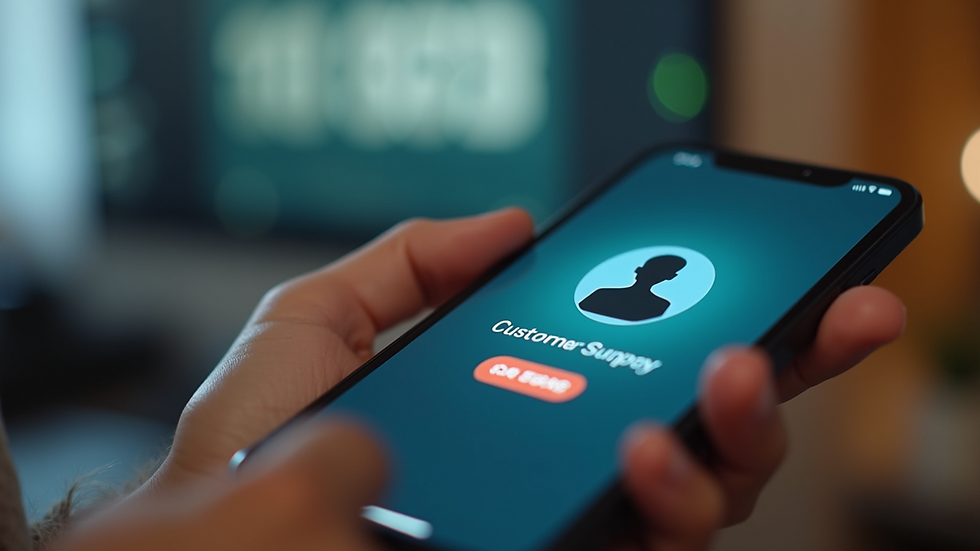How to Reach Out to Customer Support Effectively
- Adynox Industries

- May 29
- 4 min read
Updated: Jul 13
Reaching out to customer support can feel daunting. Whether you're dealing with a malfunctioning product, a billing issue, or a service disruption, knowing how to communicate your problem can make a world of difference. Getting timely help often depends on how you approach the situation. This guide aims to arm you with strategies to effectively engage customer support representatives, ensuring your issues are addressed swiftly and conveniently.
Understanding Customer Support
Customer support involves the services provided by a company to assist its customers in resolving issues. It plays a crucial role in maintaining customer satisfaction and loyalty. Businesses often use different channels for customer support, including phone, email, and live chat. Understanding the various options available can help you choose the right channel for your needs.

For instance, many companies now offer live chat options on their websites. This can be advantageous for quick inquiries, allowing you to interact in real time without waiting for email responses. However, for more complex issues, a direct phone call may be more effective.
Preparing to Contact Customer Support
To ensure a productive conversation with customer support, preparation is key. Before reaching out, take some time to gather relevant information. This can include:
Your account details
Order numbers or product serial numbers
A clear description of the issue
Additionally, jotting down any steps you’ve already taken to troubleshoot the problem can help the representative assist you more effectively.

Doing so not only saves time but also helps avoid repeated questions. Keep in mind that time is often of the essence in customer support scenarios, and being organized can help expedite the resolution process.
Choosing the Right Time to Contact
Timing can significantly affect your experience with customer support. If you choose to call, consider the time of day. Many companies experience high call volumes during peak hours, typically between 9 AM and 5 PM. If your schedule allows, try contacting them early in the morning or late in the afternoon.
Many businesses provide operational hours on their websites. Checking these hours can direct you on the best times to reach support. If you're opting for live chat or email, sending your inquiry during off-peak times may lead to faster responses.

Additionally, look for any announcements or updates that may affect customer support availability. Companies often inform customers about system outages or maintenance periods on their websites. Being informed can save you unnecessary wait times.
Communicating Clearly and Calmly
When you finally get in touch with customer support, communication is crucial. Start the conversation by politely introducing yourself and clearly stating your problem. It’s essential to remain calm even if you’re frustrated. A polite tone can significantly influence the outcome of your conversation.
Here are some tips for effective communication:
Be Concise: Summarize your issue in a few sentences without rambling.
Stay Calm: If you're frustrated or upset, take a deep breath before speaking.
Active Listening: Pay attention to the representative's guidance, and don’t hesitate to ask for clarification if necessary.
Using specific language rather than vague terms can also be beneficial. For example, instead of saying “it doesn’t work,” specify what “it” is and describe what happens when you try to use the product or service.
Following Up on Your Inquiry
If your issue isn’t resolved during the initial conversation, you may need to follow up. Doing so can ensure your request doesn't fall through the cracks. When you follow up, refer to your previous conversation for context. Here’s how to navigate the process:
Gather Information: Keep records of your previous interactions, including dates, conversation summaries, and representative names.
Choose the Right Channel: If you initially contacted support via email, you might follow up with a phone call for quicker results.
Be Persistent But Polite: It’s acceptable to remind the support team of outstanding issues. A polite nudge often goes a long way.
Using centralized resources can also be beneficial. For example, check the company’s customer service contacts page for additional ways to reach out, should you need to escalate the issue.

Every company has its own procedures for handling follow-ups, and staying informed can help ensure your concerns are prioritized.
Evaluating Your Customer Support Experience
Once your issue is resolved, it can be helpful to take a moment to reflect on your experience with customer support. Consider aspects such as:
Response Time: Was your issue addressed in a timely manner?
Resolution Quality: Were you satisfied with how your problem was handled?
Overall Interaction: Did you feel valued and respected throughout your interaction?
Providing feedback, whether positive or negative, can also be beneficial to the company. Many organizations value customer insight as it can help them improve their services.
Engaging with Customer Support Beyond Issues
Customer support is not just about resolving complaints. Many companies have customer support representatives who can assist with questions regarding products, services, or features. Engaging with support proactively can offer you insights and enhance your experience as a customer.
Don’t hesitate to ask questions about services you have yet to use or seek advice on maximizing your existing product. Good customer support teams thrive on being helpful, and they can offer you valuable information to assist with your needs.
Maintaining a respectful and pleasant demeanor can contribute to a positive ongoing relationship with customer support teams. Following these guidelines can set a tone that encourages openness and support.
Final Thoughts on Reaching Customer Support
Effective communication with customer support representatives can make a significant difference in resolving your issues efficiently. From preparing your information in advance to following up on inquiries, taking these steps can streamline the process. Remember, the goal is not just to resolve problems but to build a positive relationship with your service providers. By practicing patience and clarity, you enhance the likelihood of achieving a successful outcome.

In today's fast-paced world, customer support remains an essential tool for maintaining customer satisfaction and loyalty. Your voice matters, and navigating customer service effectively can lead to improved outcomes for both you and the companies you engage with.




Comments